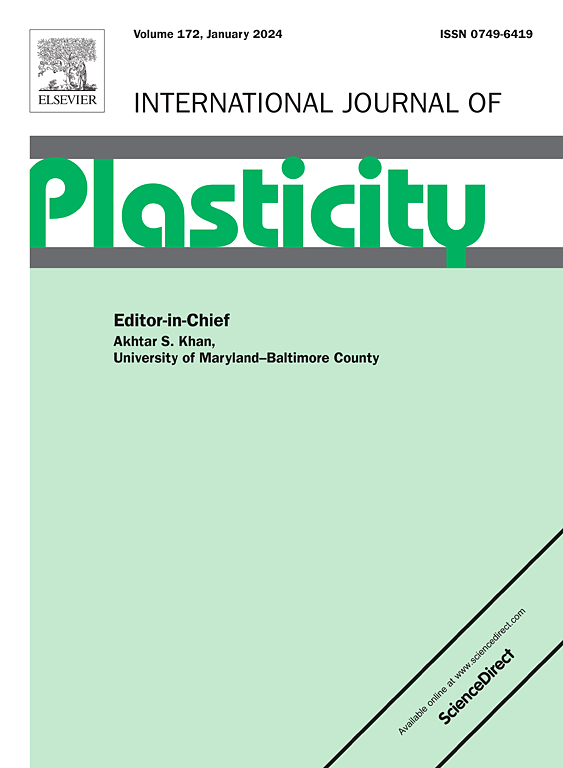Bi-directional dynamic recrystallization behavior of AZ31 alloy by Al-RE precipitation control
IF 9.4
1区 材料科学
Q1 ENGINEERING, MECHANICAL
引用次数: 0
Abstract
Texture weakening by dynamic recrystallization (DRX) control has been a challenging issue on improving the mechanical performance of wrought Mg alloys. Here we report the attainment of bi-directional DRX in an AZ31-0.9Nd-0.3Y alloy, which accelerated DRX and weakened the basal texture. The nature and content of secondary phase particles in the solidification microstructures were modified by the mixed-addition of rare-earth elements, and a dispersive distribution of Al11RE3 particles located at grain boundaries (GBs) and grain-interior Al2RE particles was achieved in the AZ31-0.9Nd-0.3Y alloy. Compared with the AZ31 and the alloys with sole-element addition, DRX in AZ31-0.9Nd-0.3Y occurred at a smaller critical strain at the same strain rate and extrusion temperature. Upon extrusion, GB bulging, continuous DRX, twin-induced nucleation and particle-stimulated nucleation (PSN) were operative but play a different part in the different stages of deformation. The Al11RE3 and Al2RE particles induced respectively inward and outward growth of DRXed grains at large strains, representing a bi-directional DRX behavior. The twin-induced DRX ceased to occur while the PSN carried by grain-interior particles caused substantial orientation randomness of the DRXed grains. Multiple dislocation slip systems were activated in the particle deformation zones to form dislocation cells, nucleating DRXed grains with a rich variety of orientations in the neighborhood of the particles. The extruded AZ31-0.9Nd-0.3Y alloy exhibited simultaneous improvement of strength and ductility performance.
Al-RE析出控制AZ31合金双向动态再结晶行为
动态再结晶控制织构弱化是提高变形镁合金力学性能的一个具有挑战性的问题。本文报道了AZ31-0.9Nd-0.3Y合金双向DRX的实现,加速了DRX的发生,削弱了基体织构。稀土元素的混合添加改变了AZ31-0.9Nd-0.3Y合金凝固组织中二次相颗粒的性质和含量,使Al11RE3颗粒分散分布在晶界(GBs)和晶内Al2RE颗粒。与AZ31和添加基体元素的合金相比,在相同应变速率和挤压温度下,AZ31-0.9 nd -0.3 y合金的DRX发生在较小的临界应变下。挤压后,GB胀形、连续DRX、双诱导形核和粒子激发形核(PSN)均起作用,但在不同变形阶段的作用不同。在大应变下,Al11RE3和Al2RE分别诱导DRX晶粒向内和向外生长,表现为双向DRX行为。孪晶诱导的DRX不再发生,而晶粒内部颗粒携带的PSN导致DRX晶粒的取向随机性较大。在晶粒变形区激活多个位错滑移体系形成位错胞,在晶粒附近形成取向丰富多样的DRXed晶粒。挤压后的AZ31-0.9Nd-0.3Y合金的强度和塑性同时得到提高。
本文章由计算机程序翻译,如有差异,请以英文原文为准。
求助全文
约1分钟内获得全文
求助全文
来源期刊

International Journal of Plasticity
工程技术-材料科学:综合
CiteScore
15.30
自引率
26.50%
发文量
256
审稿时长
46 days
期刊介绍:
International Journal of Plasticity aims to present original research encompassing all facets of plastic deformation, damage, and fracture behavior in both isotropic and anisotropic solids. This includes exploring the thermodynamics of plasticity and fracture, continuum theory, and macroscopic as well as microscopic phenomena.
Topics of interest span the plastic behavior of single crystals and polycrystalline metals, ceramics, rocks, soils, composites, nanocrystalline and microelectronics materials, shape memory alloys, ferroelectric ceramics, thin films, and polymers. Additionally, the journal covers plasticity aspects of failure and fracture mechanics. Contributions involving significant experimental, numerical, or theoretical advancements that enhance the understanding of the plastic behavior of solids are particularly valued. Papers addressing the modeling of finite nonlinear elastic deformation, bearing similarities to the modeling of plastic deformation, are also welcomed.
 求助内容:
求助内容: 应助结果提醒方式:
应助结果提醒方式:


